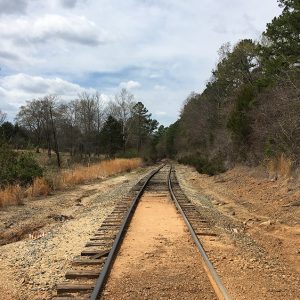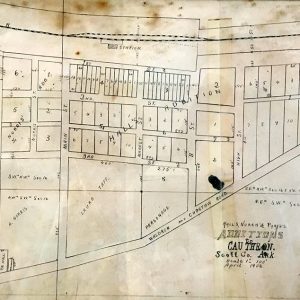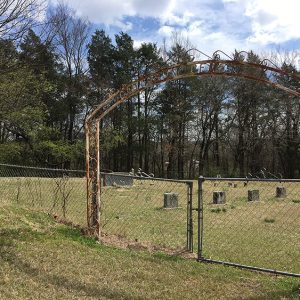calsfoundation@cals.org
Cauthron (Scott County)
The town of Cauthron is an unincorporated community located in western Scott County along Highway 28. The town was established along the Poteau River, which runs west into eastern Oklahoma. Cauthron was incorporated circa 1876; however, the area was initially known as Piney. Piney was never officially an incorporated town, and it is unclear when the area began being called Cauthron, although it was likely in the 1870s when the first governmental buildings were being built.
Before European contact, the wilderness area’s first inhabitants included natives from the Archaic, Woodland, and Mississippian periods. The Caddo later made their homes along the Poteau River and other waterways in the area.
It is probable that during the late seventeenth and early eighteenth centuries, French trappers and traders traversed the Poteau River and other waterways in the area. Stories of Spanish exploration throughout the area in the late eighteenth century exist but are unsubstantiated.
During the Civil War, the area around Cauthron was the site of several bushwhacking incidents. In 1863, Herbert Park and his son, Herbert Jr., were hanged by bushwhackers. They are buried in Kirk Field near the Poteau River. In 1870, James M. Bethel, who was a member of the Arkansas General Assembly, disappeared on his way to Little Rock (Pulaski County). He was later found dead on Poteau Mountain. Nelson Kirk, who settled near Cauthron (then Piney), donated land for Kirk Cemetery, which was established circa 1870.
The town of Cauthron was named after Judge Joe Cauthron, who lived near Greenwood (Sebastian County). Cauthron is reported to have been established by Asbury Tyler around 1876. Tyler built a sawmill and grist mill soon after settling in the area. In addition to the two mills, Cauthron had several stores, a blacksmith shop, and a woodworking shop when it was first incorporated. Cauthron was also the first town in the county to have a high school. Eventually, Cauthron had around a dozen stores located near the lower cemetery. Cauthron’s first post office was built in 1871 but was discontinued a year later. The town’s post office was reestablished in 1878. In 1881, Tyler donated lumber from his mill to build a schoolhouse, which was constructed by Bill Dawsett. Tyler also donated timber for several churches in the area. In 1892, Charles A. Atkins moved to Cauthron, becoming the town’s first doctor.
In May 1882, the Scott County Courthouse burned, thus destroying all records that defined the boundaries of the various school districts that had been established throughout the county. Several months later in August, the county court re-established the boundaries of the fifty-six school districts active in the county, including Cauthron (Number 26). The school was also known as the Page School House.
In 1904, the Arkansas Western Railroad, a subsidiary of the Kansas City Southern (KCS), built a 31.7-mile line east from Heavener, Oklahoma, to Waldron (Scott County) in order to service the timber industry. Cauthron was one of several towns along the route and built a small train depot that same year. After the railroad was built, all of the existing stores were moved north near the depot. Several additional sawmills were also established in Cauthron.
By 1904, Cauthron was one of several towns in the county receiving a direct telephone connection to the Waldron Telephone Company. In August 1926, Cauthron hosted a local fair for people living between Hon (Scott County) and the Oklahoma state line. Around the late 1920s and early 1930s, timber became depleted in the area, causing the mills to close and many residents to leave town.
Though many of Cauthron’s residents had left after the timber mills closed, there were still some residents in the small community during World War II. Several young men from Cauthron were called to service during the war.
Cauthron’s school was consolidated with Waldron in 1940. The schoolhouse was used for many years as a community center, but it was torn down by the community in the mid-2010s. The Cauthron post office was permanently discontinued in 1973. The old post office building was still standing in Cauthron in 2018 but in derelict condition. Kirk Baptist Church is located across the highway from where the schoolhouse was located. Two cemeteries are located in Cauthron: Cauthron Cemetery and Kirk Cemetery. In 2018, the Arkansas Western Railroad still ran through Cauthron from Waldron to Heavener. A number of residents live in Cauthron in the twenty-first century, many of whom are farmers. The landscape throughout Cauthron consists of open farmland and forest along Highway 28.
For additional information:
Biographical and Historical Memoirs of Western Arkansas. Chicago: Goodspeed Publishing Company, 1891.
Cate, Michael. History of Scott County, Arkansas. Dallas: Curtis Media Corporation, 1991.
Goodner, Norman. A History of Scott County, Arkansas. Siloam Springs, AR: Bar D Press, 1941.
McCutcheon, Henry Grady. History of Scott County, Arkansas. Little Rock: H. G. Pugh and Company, 1922.
Ty Richardson
Richardson Preservation Consulting
 Arkansas Western Railroad
Arkansas Western Railroad  Cauthron Map
Cauthron Map  Cauthron Cemetery
Cauthron Cemetery  Cauthron Post Office
Cauthron Post Office  Kirk Baptist Church
Kirk Baptist Church  Scott County Map
Scott County Map 



Comments
No comments on this entry yet.